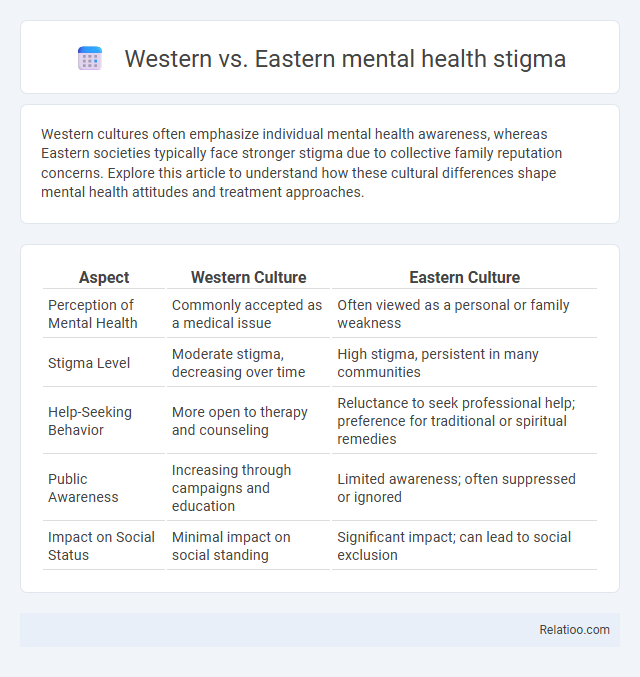Western cultures often emphasize individual mental health awareness, whereas Eastern societies typically face stronger stigma due to collective family reputation concerns. Explore this article to understand how these cultural differences shape mental health attitudes and treatment approaches.
Table of Comparison
| Aspect | Western Culture | Eastern Culture |
|---|---|---|
| Perception of Mental Health | Commonly accepted as a medical issue | Often viewed as a personal or family weakness |
| Stigma Level | Moderate stigma, decreasing over time | High stigma, persistent in many communities |
| Help-Seeking Behavior | More open to therapy and counseling | Reluctance to seek professional help; preference for traditional or spiritual remedies |
| Public Awareness | Increasing through campaigns and education | Limited awareness; often suppressed or ignored |
| Impact on Social Status | Minimal impact on social standing | Significant impact; can lead to social exclusion |
Understanding Mental Health Stigma: East vs. West
Mental health stigma varies significantly between Western and Eastern cultures, influenced by differing societal values and traditional beliefs. In Western societies, stigma often stems from individualistic views and misconceptions about mental illness, leading to social exclusion and reluctance to seek help. Eastern cultures may associate mental health issues with family honor and collective shame, resulting in higher concealment rates and less open discussion about psychological distress.
Historical Roots of Mental Health Perceptions
Historical roots of mental health perceptions reveal stark contrasts between Western and Eastern cultures. Western mental health stigma often stems from Enlightenment-era associations of mental illness with moral weakness and institutionalization, while Eastern societies traditionally link mental health to spiritual imbalance or family honor, intensifying communal judgment. Understanding these historical contexts helps You navigate and challenge the deeply ingrained stigmas affecting mental health awareness worldwide.
Cultural Influences on Mental Health Stigma
Cultural influences significantly shape mental health stigma, with Western societies often emphasizing individualism and medical models, leading to stigma centered around personal weakness or unpredictability. In contrast, Eastern cultures typically prioritize collectivism and social harmony, causing mental illness to be perceived as a threat to family reputation and community stability. These divergent cultural frameworks impact help-seeking behaviors and treatment acceptance, underscoring the need for culturally sensitive mental health interventions.
Family Dynamics: Western Openness vs. Eastern Privacy
Western mental health stigma often diminishes due to open family dynamics that encourage dialogue and emotional expression, promoting early intervention and support. Eastern family systems prioritize privacy and honor, which can perpetuate stigma by discouraging discussion and seeking help outside the family unit. Understanding these cultural nuances helps you navigate mental health conversations and tailor effective support strategies in diverse environments.
The Role of Religion and Spirituality
Religion and spirituality profoundly shape mental health stigma in both Western and Eastern cultures, influencing perceptions and treatment approaches. In many Eastern societies, spiritual beliefs often intertwine with mental health, attributing conditions to karma or spiritual imbalance, which can either provide community support or exacerbate stigma. Your understanding of how religious frameworks impact stigma is crucial for effective mental health interventions that respect cultural values and promote compassionate care.
Media Portrayal of Mental Illness in East and West
Media portrayal of mental illness in Western countries often emphasizes individual recovery stories and destigmatization efforts, promoting open dialogue and awareness. In contrast, Eastern media may depict mental health issues with more caution or negative stereotypes, reflecting cultural values that prioritize social harmony and family reputation. These differences in representation contribute significantly to varying levels of mental health stigma across East and West, influencing public perception and willingness to seek treatment.
Access to Mental Health Care: Barriers and Beliefs
Western mental health stigma often centers on individual responsibility and fear of social judgment, leading to reluctance in seeking professional help due to concerns about personal weakness and career impact. Eastern mental health stigma is deeply rooted in cultural beliefs emphasizing family honor and social harmony, creating barriers where emotional distress is minimized or hidden to avoid shame. These contrasting perspectives contribute to significant disparities in access to mental health care, with Western societies facing challenges in overcoming personal stigma and Eastern populations grappling with communal and cultural deterrents to treatment.
Social Consequences and Discrimination
Western mental health stigma often leads to social isolation and workplace discrimination, fueled by beliefs in individual responsibility and weakness. In Eastern cultures, stigma is deeply rooted in collectivist values, resulting in social exclusion and family dishonor, which can discourage individuals from seeking help. Both regions experience significant social consequences and discrimination that hinder mental health treatment and recovery.
Changing Attitudes: Emerging Trends in Both Regions
Western and Eastern societies exhibit evolving attitudes toward mental health stigma, with Western regions increasingly embracing open dialogue and therapeutic approaches, while Eastern cultures gradually integrate traditional values with modern mental health practices. Rising awareness campaigns and digital platforms contribute to destigmatization in the West, whereas community-based interventions and shifting generational perspectives drive change in the East. Both regions demonstrate a convergence toward acceptance, marked by reduced discrimination and enhanced accessibility to mental health resources.
Bridging the Gap: Strategies to Reduce Mental Health Stigma
Bridging the gap between Western and Eastern mental health stigma requires culturally sensitive strategies that address unique social norms and beliefs influencing perceptions of mental illness. You can reduce mental health stigma by promoting open dialogues, increasing mental health literacy through community education, and integrating traditional and modern therapeutic approaches tailored to diverse cultural contexts. Collaborative efforts involving healthcare providers, community leaders, and policymakers play a crucial role in fostering inclusive environments that support mental well-being across different cultural backgrounds.

Infographic: Western vs Eastern mental health stigma
 relatioo.com
relatioo.com